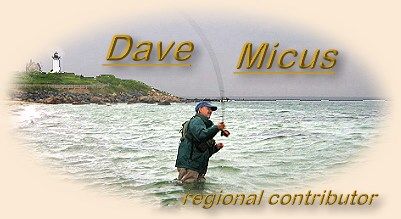
| ||
|
April 5th, 2004
|
|
2. Add deck rigging to your kayak if the boat didn't come with it. You can buy the hardware and the bungee cord from any kayak dealer; just make sure that the hardware is either plastic or stainless steel. You can clip your paddle leash to the deck rigging, and also use it for carrying things like your stripping basket, water bottle, kayak cart, or anything else you bring along. I prefer my rigging to be on the stern, lessening the chance of line tangles. 3. Buy a hard foam sleeping bag cushion (Coleman sells nice ones) and cut it to fit on the floor of your kayak. This not only provides additional flotation should you capsize, but it also deadens any noise you might make by banging the rod butt, etc. on the floor. 4. Cushion your cockpit cowl to avoid noise. I've been able to paddle right into the middle of a school of feeding stripers without them seeming to notice, but they take off in a flash if I inadvertently bang the paddle against the boat. An old garden hose, cut to the right length, split down the middle, and attached with a waterproof adhesive works well. 5. Keep obstructions to a minimum. The last thing you need is to be untangling line while the current is dragging you away from a school of feeding fish. If you add a rod holder to your boat, make sure that it is positioned out of the way but still within reach, preferably behind you. Water bottles, chest packs, etc., need to be stowed out of the way (but still accessible). 6. Always troll when you are paddling from one spot to another. This will help you locate fish that aren't visibly feeding. A rod holder makes trolling easier, but you can also troll by placing the butt of the rod on the floor between you knees and keep the rod pointing straight ahead over the bow. Let out enough line so that you are able to loosely hold the line in your dominant hand as you paddle (but be certain to keep enough slack between the line in your hand and the rod tip so that the rod stays stationary). When a fish hits the trolled fly it won't jerk your rod overboard. Another way to troll is to wedge the rod, pointing toward the stern, between your leg and the sides of the kayak. Your leg will keep the rod from going overboard when a fish takes the fly. 7. Judge the tide, current and drift before you start fishing. If there is a strong current you want to get up current from a school of fish so that you can get in as many casts as possible as you drift through the school. If you drift through a school of feeding fish and they don't take the fly, try approaching from a different angle, either from the side or the back of the school. I've been in schools of feeding bass when they would only take a fly cast from a particular side or angle. If you leave your kayak to fish from shore on an incoming tide, be sure to pull the boat a good ways from the water's edge. This will save you from running to save your boat as the tide takes it away, which will only happen, of course, when you have a good fish on. And only fish from the kayak when the weather and water conditions are safe to do so. 8. Invest (or make) a folding kayak cart. These make moving the kayak much easier, particularly over long distances like beaches that you can't approach with your car. Try to buy a cart with oversized inflatable tires that can handle most terrain. When you're ready to launch you can fold the cart and secure it to the deck rigging on the stern.
About Dave: Dave Micus lives in Ipswich, Massachusetts. He is an
avid striped bass fly fisherman, writer and instructor.
He writes a fly fishing column for the Port City Planet
newspaper of Newburyport, MA (home of Plum Island and Joppa Flats)
and teaches a fly fishing course at Boston University.
Dave Micus lives in Ipswich, Massachusetts. He is an
avid striped bass fly fisherman, writer and instructor.
He writes a fly fishing column for the Port City Planet
newspaper of Newburyport, MA (home of Plum Island and Joppa Flats)
and teaches a fly fishing course at Boston University.
|
|
Previous Dave Micus Columns If you would like to comment on this or any other article please feel free to post your views on the FAOL Bulletin Board! 
|